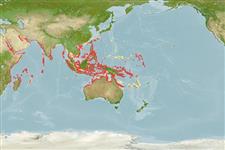>
Gobiiformes (Gobies) >
Gobiidae (Gobies) > Gobiinae
Eponymy: Dr Frederik Petrus Koumans (1905–1977) was a Dutch ichthyologist who was Curator of Fishes at Rijksmuseum van Natuurlijke Historie (Leiden, Netherlands). [...] Gordon Hector (1918–2001) was Chief Secretary to the Government of the Seychelles, in which capacity he was honoured for his ‘great assistance’ to Smith’s work about the archipelago. [...] (Ref. 128868), visit book page.
More on author: Smith.
Environment: milieu / climate zone / εύρος βάθους / distribution range
Οικολογία
Θαλασσινό(ά) Υφαλόφιλο(α); εύρος βάθους 3 - 30 m (Ref. 90102), usually 5 - 20 m (Ref. 27115). Tropical; 22°C - 30°C (Ref. 27115); 30°N - 22°S, 32°E - 175°E
Indo-West Pacific: from Seychelles to Fiji; north to Japan, south to New Caledonia.
Μέγεθος / Βάρος / Age
Γεννητική Ωρίμανση: Lm ? range ? - ? cm
Max length : 8.5 cm SL αρσενικό/απροσδιόριστο; (Ref. 48637)
Short description
Κλείδες προσδιορισμού | Μορφολογία | Μορφομετρία
Ραχιαίες άκανθες (συνολικά) : 7; Μαλακές ραχιαίες ακτίνες (συνολικά) : 15 - 17; Εδρικές άκανθες: 1; Μαλακές εδρικές ακτίνες: 15 - 16. This species is distinguished by the following characters: D VI + I,15-17; A I,15-16; pectoral-fin rays 16-17; scales in longitudinal series 49-54, in transverse series 17-18; interorbital wide, 67-90 % of eye diameter; rear margin of upper jaw ending posteriorly slightly behind or at vertical through anterior margin of eye; first two dorsal-fin spines filiform, elongate, remaining progressively shorter, the sixth dorsal-fin spine almost reaches the origin of the second dorsal; small ctenoid scales on body, cycloid at axil of pectoral fin, nape and entire belly, and in the area between first dorsal fin and pectoral fin; predorsal scales 16-22, scales not reaching to the vertical through the posterior edge of eye, ending at the level of pore G or H'; cheek and opercle naked; scales cover the basal 1/3-1/4 of caudal fin, becoming rapidly smaller and cycloid; prepectoral area with about 4-9 vertical series of fine cycloid scales covering the entire base of the pectoral fin; prepelvic area with cycloid scales, 9-14 in the midventral row; width at anal-fin origin 9.9-10.7% of SL; caudal peduncle depth 75.4-88.9% of its length; head depth 47.3-54.4% of HL; length of 11th second dorsal-fin ray 11.8-14.2% of SL; length of 8th anal-fin ray 13.7-14.9% of SL (Ref. 119548).
Body shape (shape guide): elongated; Cross section: compressed.
Inhabits sheltered bays and inner reefs on fine rubble shaded by large living corals (Ref. 48637). Occurs solitarily, hovering a short distance above sandy bottoms of reef bases. Stomach contents of one specimen comprise of filamentous algae, harpacticoid copepods, ostracods, amphipods, and nematodes (Ref. 9360).
Life cycle and mating behavior
Γεννητική Ωρίμανση | Αναπαραγωγή | Γεννοβολία | Αβγά | Γονιμότητα | Προνύμφες
Kovačić, M., S.V. Bogorodsky, A.O. Mal and T.J. Alpermann, 2018. Redescription of the genus Koumansetta (Teleostei: Gobiidae), with description of a new species from the Red Sea. Zootaxa 4459(3):453-481. (Ref. 119548)
IUCN Red List Status (Ref. 130435: Version 2025-1)
Threat to humans
Harmless
Human uses
αλιεία: Εμπορικό(ά); Ενυδρείο: Εμπορικό(ά)
Εργαλεία
Special reports
Download XML
Διαδικτυακές πηγές
Estimates based on models
Preferred temperature (Αναφ.
123201): 24.7 - 29.2, mean 28.4 °C (based on 320 cells).
Phylogenetic diversity index (Αναφ.
82804): PD
50 = 0.6250 [Uniqueness, from 0.5 = low to 2.0 = high].
Bayesian length-weight: a=0.00724 (0.00339 - 0.01546), b=3.10 (2.92 - 3.28), in cm total length, based on LWR estimates for this (Sub)family-body shape (Ref.
93245).
Τροφικό Επίπεδο (Αναφ.
69278): 2.1 ±0.1 se; based on diet studies.
Ελαστικότητα (Αναφ.
120179): Υψηλό, ελάχιστος χρόνος για διπλασιασμό πληθυσμού < 15 μήνες (Preliminary K or Fecundity.).
Fishing Vulnerability (Ref.
59153): Low vulnerability (10 of 100).
🛈
Nutrients (Ref.
124155): Calcium = 162 [70, 326] mg/100g; Iron = 0.867 [0.407, 1.738] mg/100g; Protein = 17.4 [15.4, 19.2] %; Omega3 = 0.0835 [, ] g/100g; Selenium = 26 [12, 64] μg/100g; VitaminA = 114 [24, 529] μg/100g; Zinc = 2.67 [1.65, 4.09] mg/100g (wet weight);
